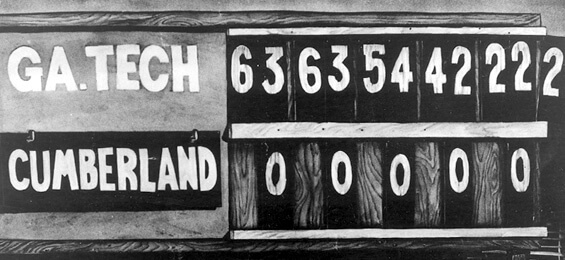Warm up for the big game by reading about the biggest blowout in football history

We explore some of Wikipedia’s oddities in our 6,244,127-week series, Wiki Wormhole.
This week’s entry: 1916 Cumberland vs. Georgia Tech Football Game
What it’s about: Are you ready for some football? Because in 1916, Cumberland College was decidedly not, as in the leather-helmet era of football, when 6-0 was considered a rousing game, the Cumberland Bulldogs lost to the Georgia Tech Engineers by a remarkable 222-0, still the most lopsided game in the history of football. To put things in perspective, the biggest blowout in NFL history was when Chicago beat Washington 73-0 in the 1940 title game.
Biggest controversy: Cumberland had to be coerced into even showing up for the game. The Lebanon, Tennessee-based college had shuttered its football program before the season started, but they were still contracted to play Georgia Tech, and Tech coach and trophy namesake John Heisman insisted they meet their obligation. Voiding the contract would mean a $3,000 forfeit (almost $76,000 in today’s money), and Heisman sweetened the pot by paying them $500 “and an all-expenses-paid trip to Atlanta” to play the game.
Rumor has it Heisman was out for revenge, as Cumberland had embarrassed Georgia Tech’s baseball team (which Heisman also coached) earlier that year, beating them 22-0 in a game in which Cumberland was alleged to have used professional players as ringers. It’s thought Heisman ran up the score to 222 as pointed revenge for that 22-0 loss. College football teams were also ranked based on points scored, so beating up on a weak opponent was a good way to become a top-ranked team.
Strangest fact: Cumberland’s football team was primarily made up of law students. As the school no longer had a football program, they asked the baseball team’s student manager to recruit some players, and he asked his fraternity brothers and fellow law students. The manager, George E. Allen, graduated with a law degree and went on to be a “political operative and crony” for FDR, Truman, and Eisenhower. He was also named head football coach for the duration of that one game, which has to give him the worst lifetime record in the history of coaching any sport.
Thing we were happiest to learn: Heisman eventually took it easy on ’em. After a tongue-in-cheek halftime speech, in which he told his players, “You just can’t tell what those Cumberland players have up their sleeves. They may spring a surprise. Be alert, men!”, he agreed to shortening the third and fourth quarters to 12 minutes instead of 15, so Cumberland’s suffering would be over faster.
Thing we were unhappiest to learn: Football used to be even worse at protecting their players from injury. Cumberland QB Edwards (no first name given) was taken off the field with concussions three times during the game. Cumberland’s only effective play was a blocked extra point, which they managed by forming a human pyramid, but Vichy Woods, the player at the top, “suffered a gruesome facial injury.” It’s not clear that he blocked the ball with his face, but that seems to be the likeliest explanation.
Also noteworthy: You can safely skip this section if you’re not familiar with football stats, but if you are, the stats are remarkable. Georgia Tech rushed for a total of 922 yards and 32 TDs. To put that in perspective, the 2020 Engineers rushed for 1,908 yards and 18 TDs in ten games. Also, Wikipedia lists 26 rushing attempts, which seems low given the 32 touchdowns. Cumberland’s running game was, shall we say, less successful, as they managed -42 yards and 9 fumbles lost. However, they led the game in passing, as Georgia Tech did not throw a pass. Edwards the first-name-less QB threw 18 passes for Cumberland—two landed in the hands of his own receivers, for a total of 14 yards. Six more were intercepted by Georgia Tech. All in all, Wikipedia estimates that Cumberland were in their own territory for 97% of the game.
Best link to elsewhere on Wikipedia: Games as lopsided as Cumberland-Georgia Tech are rare enough that the very concept of running up the score has its own page, including a list of memorably one-sided games from pro and college sports.
Further Down the Wormhole: Wikipedia includes a tragic footnote on one of the Cumberland players, Dow R. Cope—not long after the game, he enlisted in the U.S. Army Signal Corps, and died in a plane crash while serving in France during WWI. The Signal Corps were established during the Civil War, and run the all-important communications network the military relies on. Signal Corps vets who went on to fame post-service include Frank Capra, John Cheever, Tony Randall, Senator Frank Lautenberg, Supreme Court Justice Samuel Alito, and Stan Lee.
Lee is, of course, a towering figure in pop culture, having served as lead editor and writer of Marvel Comics during an era in which he (alongside artists and co-writers Jack Kirby and Steve Ditko) created countless iconic comic book characters, who have now become iconic movie characters under the banner of the Marvel Cinematic Universe. After a COVID-related pause of nearly two years, the MCU’s “Phase Four” is set to begin later this year, with a slate of films that includes the Sam Raimi-directed Doctor Strange In The Multiverse Of Madness. Raimi is a natural choice to direct a Marvel movie, as he helped usher in the modern superhero epic with his Spider-Man series in the early 2000s. But Raimi has also missed several opportunities to direct superheroes in the past, as he had pitched a Thor movie in 1990, was considered for Batman Forever, and developed and abandoned The Shadow and Spider-Man 4 through 6. We’ll look at the remarkably long list of Sam Raimi’s Unrealized Projects next week.